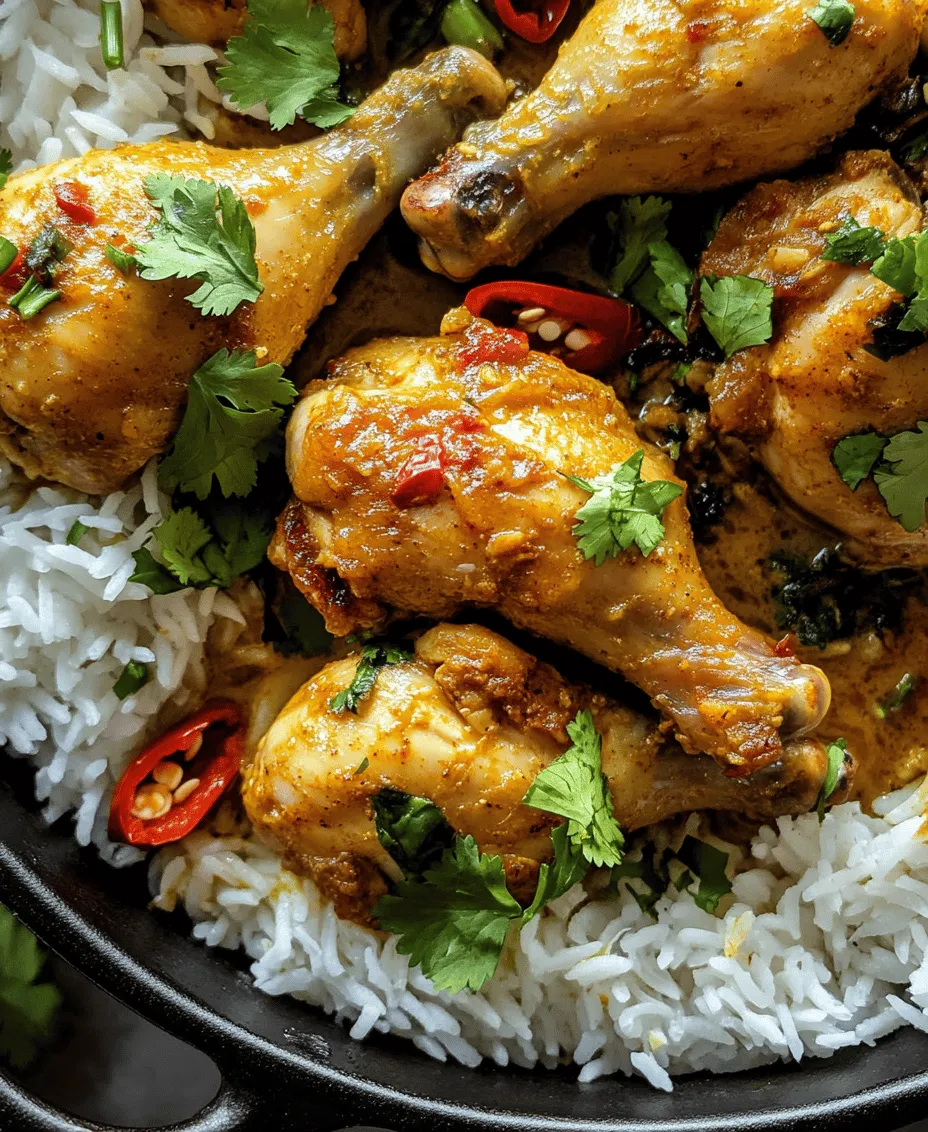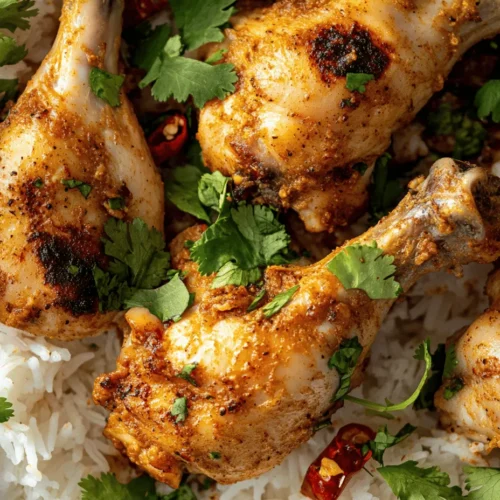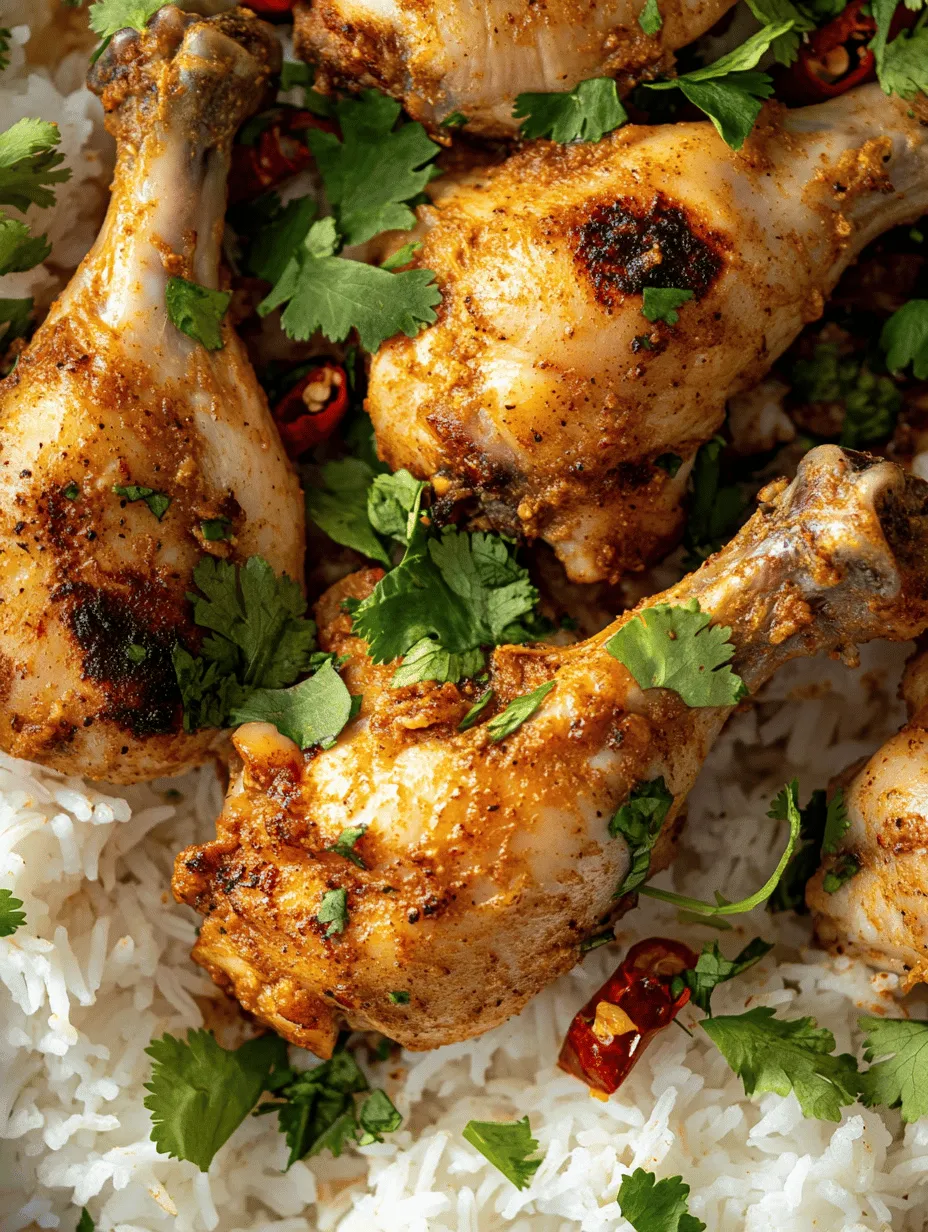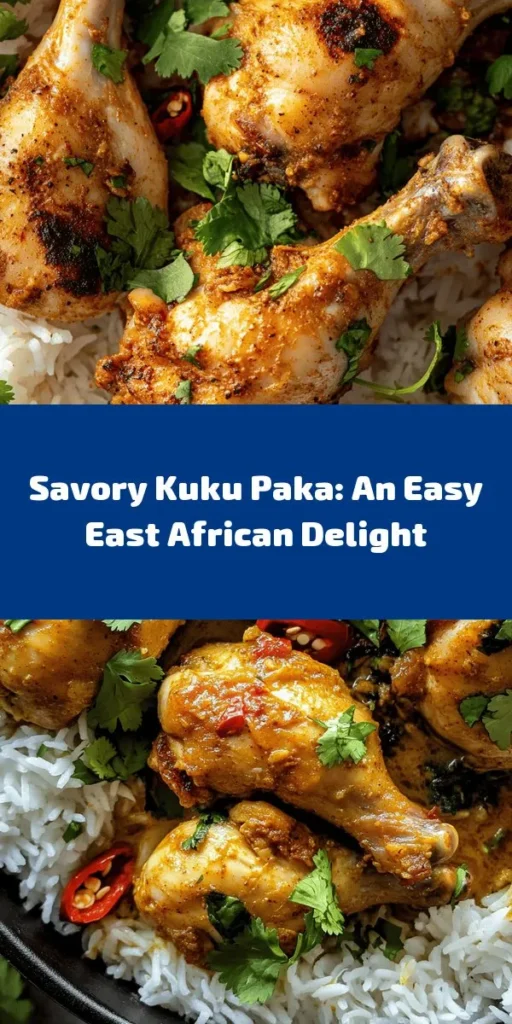Introduction
Kuku Paka is a cherished dish that hails from the vibrant coastal regions of East Africa, particularly enjoyed in countries like Kenya and Tanzania. This traditional chicken curry is celebrated not only for its delicious flavor but also for its cultural significance, often served during family gatherings, celebrations, and communal feasts. The name “Kuku Paka” translates to “chicken with coconut,” which aptly describes the dish’s main components. With its rich, creamy coconut milk base and aromatic spices, Kuku Paka encapsulates the essence of East African cuisine, bringing together the warmth of family and the joy of shared meals.
Coconut milk plays a pivotal role in East African cooking, particularly in coastal areas where coconuts thrive. It adds a luscious creaminess to dishes, balancing flavors and providing a comforting texture. The use of coconut milk in Kuku Paka not only enriches the dish but also reflects the influence of Indian and Arab cuisines that have intermixed with local traditions over centuries. This harmonious blend of cultures is evident in the ingredients and cooking methods used, making Kuku Paka a true representative of East African culinary heritage.
As you delve into the world of Kuku Paka, you will discover a dish that is both fragrant and satisfying. The chicken is tender and succulent, infused with spices that awaken the palate. The creamy coconut sauce is laced with the brightness of tomatoes and the freshness of herbs, creating a symphony of flavors that dance together on your taste buds. Whether served with rice, chapati, or ugali, Kuku Paka is sure to leave a lasting impression and transport you to the sun-kissed shores of East Africa.
The Ingredients of Kuku Paka
To prepare Kuku Paka, you will need a selection of key ingredients that not only contribute to the dish’s delightful flavors but also reflect the cultural nuances of East African cuisine. Each component plays a vital role in creating the rich tapestry of tastes and textures that make this dish so beloved.
Chicken
The star of Kuku Paka is undoubtedly the chicken. For the best results, it is recommended to use bone-in, skin-on pieces, such as thighs or drumsticks. This choice is crucial, as the bones impart flavor during the cooking process, while the skin helps to keep the meat moist and tender. The chicken absorbs the spices and coconut milk beautifully, resulting in a dish that is both juicy and flavorful. Moreover, using these cuts can add to the authenticity of the recipe, as they are traditionally favored in East African cooking.
Coconut Milk
Coconut milk is the heart of Kuku Paka, providing the rich, creamy sauce that coats the chicken. It is essential to choose high-quality coconut milk for the best flavor. The creaminess not only enhances the dish’s texture but also balances the spices, creating a harmonious blend. Coconut milk is widely used in East African cuisine, showcasing the region’s natural resources and culinary traditions. Its ability to meld with spices and aromatics makes it a staple ingredient for many dishes, especially in coastal areas where coconuts are abundant.
Aromatics
Aromatic ingredients such as onions, garlic, and ginger form the foundation of Kuku Paka. Onions add sweetness and depth, while garlic and ginger contribute warmth and a hint of spice. Sautéing these aromatics at the beginning of the cooking process is crucial for developing a rich flavor base. The fragrant aroma that fills your kitchen as you cook these ingredients is a prelude to the delicious meal that awaits.
Spices
The use of spices is an integral aspect of East African cuisine, and Kuku Paka is no exception. The primary spices used in this recipe include curry powder, ground coriander, and cumin. Curry powder adds a warm, earthy flavor, while coriander and cumin provide a slightly citrusy undertone that elevates the dish. These spices not only enhance the taste of the chicken but also reflect the region’s diverse culinary influences, showcasing the blend of African, Indian, and Arab flavors that characterize many dishes in East Africa.
Tomatoes
Tomatoes are another essential ingredient in Kuku Paka, contributing both flavor and color to the dish. They add acidity and brightness, balancing the richness of the coconut milk. Fresh tomatoes can be used for a lighter, fresher taste, while canned tomatoes are a convenient alternative that still delivers great flavor. The tomatoes help create a luscious sauce that envelops the chicken, making each bite irresistible.
Green Chilies
For those who enjoy a bit of heat, green chilies are an important addition to Kuku Paka. These fiery peppers can be adjusted according to personal preference, allowing you to customize the spice level to suit your taste. The heat from the chilies complements the richness of the coconut milk and the warmth of the spices, creating a well-rounded dish that excites the palate.
Fresh Cilantro
Finally, fresh cilantro is often used as a garnish for Kuku Paka, adding a pop of color and an herbal note that brightens the dish. The fresh flavor of cilantro balances the richness of the sauce and enhances the overall presentation. Not only does it serve as a beautiful finishing touch, but it also ties all the flavors together, making each bite a celebration of East African culinary traditions.
Preparation Process
Preparing Kuku Paka is a delightful process that allows you to immerse yourself in the vibrant flavors of East African cuisine. The steps involved are straightforward, but each one is essential for achieving the perfect dish. Let’s explore the key stages of preparation, starting with the all-important marination of the chicken.
Importance of Marinating Chicken
Marinating the chicken is a critical step in the Kuku Paka preparation process. This technique enhances both the flavor and tenderness of the meat. A typical marinade for Kuku Paka includes a blend of spices, garlic, and ginger, which penetrates the chicken, infusing it with aromatic goodness. For best results, it is recommended to marinate the chicken for at least 30 minutes, although longer marination—up to overnight in the refrigerator—will yield even more flavorful results.
Step-by-Step Guide to Sautéing Aromatics
Once the chicken is marinated, it’s time to start cooking. The first step is to sauté the aromatics, which forms the flavor base for the dish. Here’s how to achieve the perfect sauté:
1. Heat the Oil: In a large skillet or pot, heat a couple of tablespoons of cooking oil over medium heat. A neutral oil works well, but you can also use coconut oil for added flavor.
2. Add Onions: Once the oil is hot, add finely chopped onions. Sauté them until they become translucent and slightly golden, which usually takes about 5-7 minutes. This step is crucial as it develops the sweetness and depth of flavor.
3. Incorporate Garlic and Ginger: Next, add minced garlic and grated ginger to the onions. Stir them in and cook for an additional 1-2 minutes until fragrant. Be cautious not to burn the garlic, as it can turn bitter.
4. Add Spices: Now is the time to introduce the spices. Sprinkle in the curry powder, ground coriander, and cumin, stirring well to coat the onions, garlic, and ginger. Cook the spices for about 1-2 minutes, allowing their essential oils to release and deepen the flavors.
Cooking Chicken
With the aromatics and spices perfectly sautéed, it’s time to add the marinated chicken. Follow these steps for optimal results:
1. Brown the Chicken: Add the marinated chicken pieces to the skillet, skin-side down. Allow the chicken to brown undisturbed for about 5-6 minutes. This browning process not only adds flavor but also seals in the juices, enhancing the overall taste of the dish.
2. Flip and Brown the Other Side: Once the skin is golden and crispy, flip the chicken pieces to brown the other side for another 5 minutes. This step is vital for achieving a rich flavor profile.
3. Integrate Coconut Milk and Tomatoes: After the chicken is nicely browned, add the coconut milk and chopped tomatoes to the skillet. Stir to combine, ensuring that the chicken is well coated in the sauce. Bring the mixture to a gentle simmer, allowing the flavors to meld together.
4. Achieve the Right Sauce Consistency: As the sauce simmers, it will thicken slightly. If you prefer a thinner sauce, you can add a splash of water or additional coconut milk. Let the dish simmer for about 20-30 minutes, or until the chicken is fully cooked and tender. This slow cooking process allows the flavors to develop and intensify, resulting in a rich and satisfying dish.
By following these steps, you will create a mouthwatering Kuku Paka that captures the essence of East African cuisine. The combination of tender chicken, creamy coconut milk, and aromatic spices will transport you to the heart of East Africa, offering a culinary experience that is both authentic and unforgettable.

Managing Heat with Green Chilies: Balancing Flavor and Spice
When preparing Kuku Paka, the role of green chilies is pivotal in striking the perfect balance of flavor and spice. Green chilies not only add heat but also provide a fresh, vibrant taste that complements the creamy coconut sauce. However, it’s essential to manage their heat level according to your preference.
To achieve this balance, consider the type and quantity of green chilies used. For a milder flavor, you can deseed the chilies, as the seeds contain most of the heat. On the other hand, if you enjoy a spicier kick, include the seeds and increase the number of chilies. Always taste the dish as it cooks, allowing you to adjust the spice level progressively to achieve a flavor profile that suits your palate.
Cooking Kuku Paka
The Simmering Process: Importance of Low Heat for Flavor Development
Once your ingredients are prepared and combined, the next step is to let the Kuku Paka simmer. This process is crucial for flavor development, allowing the spices, coconut milk, and chicken to meld beautifully. Begin by bringing the mixture to a gentle boil, then reduce the heat to low. A slow simmer helps to tenderize the chicken while infusing it with the rich flavors of the spices and coconut.
During this simmering phase, avoid the temptation to raise the heat. High temperatures can lead to tough chicken and a sauce that lacks depth. Instead, providing a low and steady heat ensures that the chicken cooks evenly and absorbs all the wonderful flavors, resulting in a tender and juicy dish.
How to Know When the Chicken is Perfectly Cooked: Visual and Textural Cues
Determining the doneness of your chicken is essential for achieving the best Kuku Paka. The chicken should be cooked thoroughly, with the juices running clear when pierced with a fork. Visually, the meat should lose its pink color and transform into a succulent, golden hue.
Additionally, you can check the texture of the chicken. It should be tender yet firm, easily pulling apart with a fork. If you find that the chicken is still tough or has a rubbery texture, allow it to simmer a little longer. Remember, patience is key, as overcooking can lead to dryness, which we want to avoid.
Adjusting Seasoning: Taste-Testing and Balancing Flavors
As the Kuku Paka simmers, it’s vital to taste-test periodically. This step is crucial for adjusting the seasoning to your liking. You may find that the dish needs a bit more salt or a dash of lime juice for acidity, which can brighten the flavors.
Start by adding small amounts of seasoning, allowing each addition to meld into the dish before tasting again. The goal is to achieve a harmonious balance where no single flavor overpowers the others. A well-seasoned Kuku Paka should highlight the creaminess of the coconut milk while allowing the spices and chicken flavors to shine through.
The Role of Water in Achieving Desired Sauce Consistency
The consistency of the sauce can make or break your Kuku Paka experience. If the sauce is too thick, you can easily adjust this by adding water or additional coconut milk. Conversely, if the sauce is too thin, a longer simmering time can help reduce it to your desired thickness.
When adding water, do so incrementally, stirring well to incorporate it into the dish. This method allows you to control the sauce’s richness without diluting its flavor. A well-balanced sauce should be thick enough to coat the chicken while remaining pourable to soak into your chosen accompaniments.
Serving Suggestions
Traditional Accompaniments: Rice vs. Ugali and Their Cultural Significance
Kuku Paka is traditionally served with either rice or ugali, both of which are staples in East African cuisine. Rice, often fragrant and fluffy, serves as a perfect canvas for the rich, coconut-infused sauce, soaking up the flavors and providing a satisfying base for the chicken.
Ugali, on the other hand, is a dense, cornmeal-based dish that is often used to scoop up the sauce and chicken. The choice between rice and ugali often comes down to personal preference or regional tradition. Each accompaniment brings its own cultural significance, reflecting the diverse culinary practices found throughout East Africa.
Presentation Tips: How to Serve for a Visually Appealing Dish
Presentation plays a significant role in enhancing the dining experience. To serve Kuku Paka attractively, consider the following tips:
– Use a shallow serving dish to showcase the vibrant colors of the chicken and sauce.
– Garnish with freshly chopped cilantro or parsley for a pop of color and added freshness.
– Serve with a side of lime wedges to add a bright touch, inviting guests to squeeze them over their portions for an extra zing.
– If serving with rice, mold the rice into a small mound for an elegant touch.
These simple presentation techniques can elevate your dish, making it not only delicious but also visually appealing.
Pairing Kuku Paka with Beverages: Traditional Drinks That Complement the Meal
Pairing beverages with your Kuku Paka can further enhance the dining experience. Traditional East African drinks such as chai tea or freshly squeezed mango juice complement the rich flavors of the dish beautifully.
Chai tea, with its aromatic spices, provides a warm contrast to the creamy chicken, while mango juice adds a refreshing sweetness that balances the dish’s heat. For those looking for an alcoholic option, consider serving a light beer or a fruity white wine, which can cleanse the palate between bites.
Cultural Context and Variations
Exploring the Origins of Kuku Paka in East African Cuisine
Kuku Paka has its roots in the coastal regions of East Africa, particularly among Swahili communities. This dish is a beautiful blend of African, Arab, and Indian culinary influences, reflecting the rich cultural tapestry of the region. The use of coconut milk, spices, and chicken showcases the flavors that are prevalent in coastal cooking, where seafood and rich sauces are often staples.
Regional Variations of Kuku Paka: How Different Cultures Interpret the Dish
As Kuku Paka has spread across different regions, various adaptations have emerged. For example, in some areas, the dish may incorporate seafood, such as prawns or fish, instead of chicken, taking advantage of the coastal bounty. Others may include vegetables or legumes, appealing to those following vegetarian diets.
These regional variations highlight the versatility of Kuku Paka, allowing each culture to put its own unique spin on this beloved dish while maintaining the core flavors that define it.
The Significance of Kuku Paka in Celebrations and Communal Dining
Kuku Paka is often served during special occasions and communal gatherings, symbolizing hospitality and togetherness. In many East African cultures, sharing a meal is a way to foster community bonds, and Kuku Paka, with its rich flavors and communal serving style, plays an essential role in these traditions.
Whether for weddings, festivals, or family reunions, Kuku Paka is a dish that brings people together, making it a cherished part of East African culinary heritage.
Modern Adaptations: Vegetarian or Alternative Protein Versions of Kuku Paka
In response to growing dietary preferences, modern adaptations of Kuku Paka have emerged, focusing on vegetarian or alternative protein versions. These adaptations may include tofu, tempeh, or a variety of vegetables simmered in the same rich coconut sauce, allowing those who prefer plant-based meals to enjoy the flavors of this traditional dish without compromising on taste.
These variations not only make Kuku Paka more accessible to a broader audience but also showcase the dish’s flexibility in accommodating diverse dietary needs.
Nutritional Information
Overview of the Nutritional Benefits of the Ingredients Used
Kuku Paka is not only delicious but also offers several nutritional benefits. The primary ingredients—chicken, coconut milk, and spices—contribute to a well-rounded dish. Chicken is an excellent source of protein, essential for muscle repair and overall health. Coconut milk, while rich in calories, provides healthy fats that can support heart health when consumed in moderation.
The spices used, including turmeric and ginger, also offer health benefits, such as anti-inflammatory properties and digestive support. When served with vegetables or a side salad, Kuku Paka can create a balanced meal rich in nutrients.
Balancing Flavors and Nutrition: How to Enjoy Kuku Paka Healthily
To enjoy Kuku Paka in a health-conscious way, consider portion sizes and serving styles. Opt for lean cuts of chicken, such as skinless breasts or thighs, to reduce saturated fat intake. Additionally, pairing the dish with a hearty serving of vegetables can enhance its nutritional profile.
For those watching their calorie intake, being mindful of the amount of coconut milk used can help. You can substitute part of the coconut milk with low-sodium chicken broth or add extra vegetables to stretch the sauce further while maintaining flavor.
Discussing Portion Sizes and Serving Suggestions for Balanced Meals
When serving Kuku Paka, aim for balanced portion sizes. A standard serving could be around 4-6 ounces of chicken along with a cup of rice or ugali and a side of vegetables. This balance ensures that you enjoy the dish’s rich flavors while keeping nutritional needs in check.
Additionally, consider serving a light salad or steamed vegetables alongside Kuku Paka to add fiber and nutrients to your meal. This approach not only enhances the dining experience but also promotes a healthier balance in your diet.
Conclusion
Kuku Paka stands as a delicious representation of East African flavors, showcasing the region’s culinary diversity and rich cultural heritage. This dish, with its creamy coconut sauce, tender chicken, and vibrant spices, offers a delightful experience that appeals to a wide range of palates.
Its versatility allows for various adaptations, making it suitable for different dietary preferences while retaining the essence of its traditional roots. Whether you choose to enjoy it with rice or ugali, Kuku Paka is more than just a meal; it is an invitation to explore the flavors and traditions of East Africa.
So why not try your hand at making Kuku Paka at home? With its enticing aroma and rich flavors, this dish promises to transport you to the shores of the East African coast, allowing you to savor a taste of this vibrant culture in every bite.



